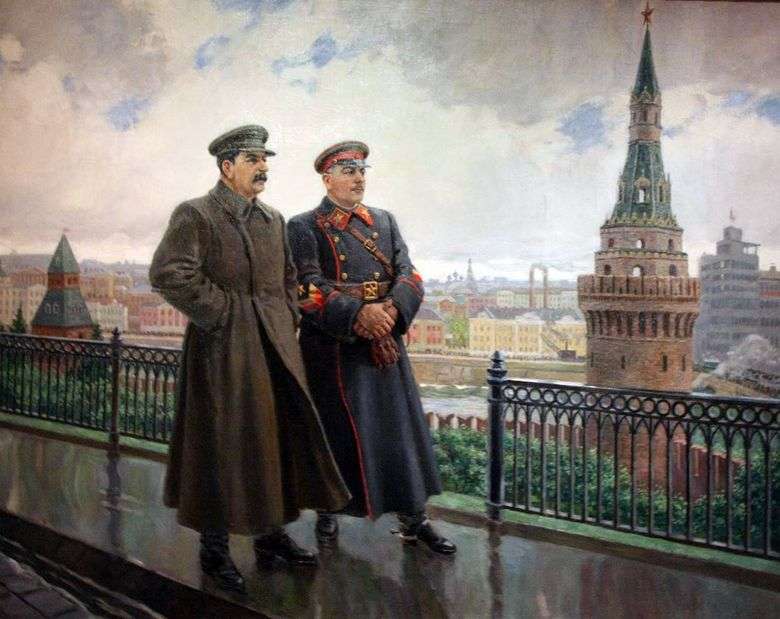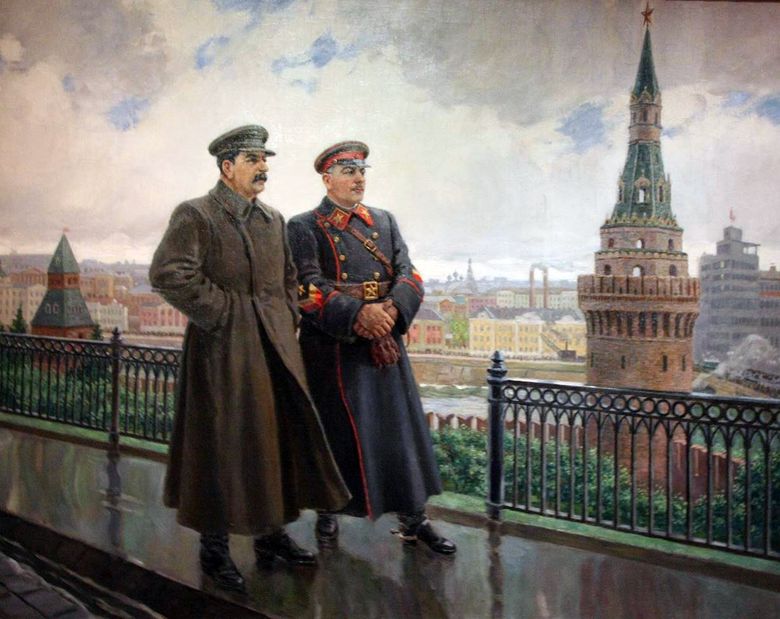
The ideological meaning of the huge canvas “IV Stalin and K. Ye. Voroshilov in the Kremlin” was to be revealed to every Soviet person clearly and clearly. Strong and unyielding Bolshevik will was read in the aspiring views of Stalin and Voroshilov. Every spectator could see that the party, the Soviet government, the Red Army experienced in the battles, stood guard over the creative labor of the Soviet people.
The ideological idea was initially emphasized also verbally: the picture was called “On guard of peace”. Peaceful work in the picture is really present. Moscow is being built, like the whole country, the Soviet Fatherland is growing stronger. In the panorama of Zamoskvorechye new buildings are visible, silhouettes of excavators; the factory chimneys are smoking, a new stone bridge stretches across the Moskva River.
The intelligentsia quietly called the picture differently – “Two chiefs after the rain”. An experienced court painter, it is no coincidence that alongside the main hero of all Soviet art, JV Stalin set the second leader of Voroshilov, namely him, and not, for example, VM Molotov or AA Zhdanov, or MI. Kalinin. Larchik comes off simply: Voroshilov was the patron saint of the artist, they were even associated with some friendly relations. AM Gerasimov wrote at least a dozen portraits of the “Iron Commissar”. And here, portraying him next to the Secretary General himself, the maestro, of course, wanted to flatter his high-ranking benefactor.
The image of the rain that has just passed is not accidental. The sophisticated adept of socialist realism subtly thought out the plot. It is subordinated to the general idea of the work and can be understood as a motive for renewal not only of nature, but of the entire Soviet country with its new, socialist system. At the same time, Alexander Gerasimov realized here his favorite landscape hobbies, which he inspired with inspiration, perhaps, in his best lyrical painting “After the Rain: A Wet Terrace”. Found once picturesque techniques he used in the official canvas.
The artist really masterfully managed to “wet”: raw benches, trees, road. And in this monumental canvas with the leaders, executed in gray-silver color, the artist expressly conveyed the after-storm clouds, the moist air, the wet asphalt pavement and the railing handrails, washed with rainwater. The picture was a success, the artist clearly pleased the powers that be. The canonical image of the leaders embodied the “Kremlin myth”, which made the canvas a “cult” work in the totalitarian era of Stalin’s rule. For her AM Gerasimov in 1941 gave another Stalin Prize.
 JV Stalin y K. Ye. Voroshilov en el Kremlin – Alexander Gerasimov
JV Stalin y K. Ye. Voroshilov en el Kremlin – Alexander Gerasimov I. V. Staline et K. E. Voroshilov au Kremlin – Alexander Gerasimov
I. V. Staline et K. E. Voroshilov au Kremlin – Alexander Gerasimov After the rain (Wet Terrace) by Alexander Gerasimov
After the rain (Wet Terrace) by Alexander Gerasimov Noon. Warm rain by Alexander Gerasimov
Noon. Warm rain by Alexander Gerasimov Portrait of the oldest Soviet artists I. Pavlov, V. Baksheev, V. Byalynitsky-Biruli and V. Meshkov by Alexander Gerasimov
Portrait of the oldest Soviet artists I. Pavlov, V. Baksheev, V. Byalynitsky-Biruli and V. Meshkov by Alexander Gerasimov Still life. Wildflowers by Alexander Gerasimov
Still life. Wildflowers by Alexander Gerasimov Aya-Sofia by Alexander Gerasimov
Aya-Sofia by Alexander Gerasimov Gifts of Autumn by Alexander Gerasimov
Gifts of Autumn by Alexander Gerasimov